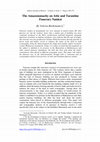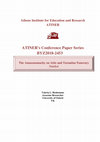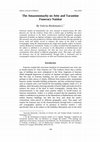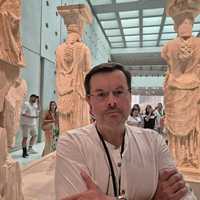Papers by Valeria Riedemann
Greek Art in Motion: Studies in honour of Sir John Boardman on the occasion of his 90th Birthday, 2019

Athens Journal of History, 2018
Funerary naiskoi of monumental size were unusual in fourth-century BC Attic funerary art, but the... more Funerary naiskoi of monumental size were unusual in fourth-century BC Attic funerary art, but the evidence shows that a similar type of building was more commonly produced in the West: architectural andrelief fragments alongside depictions of naiskoi on Apulian red-figure vases indicate that this type of templelike structure was also produced in Taranto. Relief decoration showing episodes of heroic myth and battles served to enhance the status of the dead in tomb iconography; being the Amazonomachy the single most popular subject on fourthcentury BCfunerary monuments. Today, it is widely accepted that the popularity of the subject is indebted to its presence in the Mausoleum at Halikarnassos and other eastern funerary monuments, but little has been said about the myth's connotations when placed in different geographic areas. This paper will explore the funerary uses of the Amazonomachy through both a contextual and an iconographic analysis of its presence on Attic and Tarantine funerary naiskoi.
El presente ensayo investiga como la adopcion de elementos e ideologias foraneas que se observa e... more El presente ensayo investiga como la adopcion de elementos e ideologias foraneas que se observa en el material arqueologico proveniente de Etruria tuvo que ver, aparentemente, con la creacion de una �identidad� etrusca. En este proceso, se ha argumentado que las representaciones de batallas y sacrificios inspirados en la mitologia griega presentes en monumentos funerarios hacia el final del periodo clasico, buscaban reafirmar la identidad etrusca al compararse con los heroes griegos y, de este modo, desvalorizar a los romanos. Luego de analizar el programa iconografico de dos sarcofagos provenientes de Tarquinia, veremos que tales interpretaciones no son del todo correctas, puesto que suelen ignorar importantes aspectos que obedecen a una tradicion y no representan, necesariamente, un espiritu propagandista en contra de Roma.

Funerary naiskoi of monumental size were unusual in fourth-century BC Attic funerary art, but the... more Funerary naiskoi of monumental size were unusual in fourth-century BC Attic funerary art, but the evidence shows that a similar type of building was more commonly produced in the West: architectural andrelief fragments alongside depictions of naiskoi on Apulian red-figure vases indicate that this type of temple-like structure was also produced in Taranto. Relief decoration showing episodes of heroic myth and battles served to enhance the status of the dead in tomb iconography; being the Amazonomachy the single most popular subject on fourth-century BCfunerary monuments. Today, it is widely accepted that the popularity of the subject is indebted to its presence in the Mausoleum at Halikarnassos and other eastern funerary monuments, but little has been said about the myth’s connotations when placed in different geographic areas. This paper will explore the funerary uses of the Amazonomachy through both a contextual and an iconographic analysis of its presence on Attic and Tarantine na...
Historias Del Orbis Terrarum, 2011
Grecorromana, 2020
Este breve ensayo examina una bien conocida estela helenística firmada por el escultor Arquelaos ... more Este breve ensayo examina una bien conocida estela helenística firmada por el escultor Arquelaos de Priene, proveniente de Alejandría y que data del periodo Ptolemaico. En este análisis, se examinarán algunos aspectos iconográficos de esta estela votiva y su rol en el contexto sociocultural helenístico en tanto monumento honorífico a la vez que conmemorativo. Por último y haciendo uso de algunas fuentes literarias y evidencia arqueológica, se analizará la cuestión del estatus divino de algunos poetas y su contribución a la educación (paideia) en la antigua Grecia.
In R. Morais, D. Leão, and D. Rodríguez Pérez (eds.), Greek Art in Motion: Proceedings of the Conference in Honour of Sir John Boardman on the Occasion of his 90th Birthday. Oxford: Archaeopress Archaeology, pp. 455-464., 2019
Revista Círculo Cromático, 2: 11-24, 2019
Revista Círculo Cromático, 2018

Funerary naiskoi of monumental size were unusual in fourth-century BC Attic funerary art, but the... more Funerary naiskoi of monumental size were unusual in fourth-century BC Attic funerary art, but the evidence shows that a similar type of building was more commonly produced in the West: architectural and relief fragments alongside depictions of naiskoi on Apulian red-figure vases indicate that this type of temple-like structure was also produced in Taranto. Relief decoration showing episodes of heroic myth and battles served to enhance the status of the dead in tomb iconography; being the Amazonomachy the single most popular subject on fourth-century BC funerary monuments. Today, it is widely accepted that the popularity of the subject is indebted to its presence in the Mausoleum at Halikarnassos and other eastern funerary monuments, but little has been said about the myth's connotations when placed in different geographic areas. This paper explore the funerary uses of the Amazonomachy through both a contextual and an iconographic analysis of its presence on Attic and Tarantine funerary naiskoi.
Book Reviews by Valeria Riedemann
ORBIS TERRARUM Internationale Zeitschrift für historische Geographie der Alten Welt, 2023
Journal of Roman Archaeology, 2022
BMCR 10:42, 2022
https://bmcr.brynmawr.edu/2022/2022.10.42/











Uploads
Papers by Valeria Riedemann
Book Reviews by Valeria Riedemann